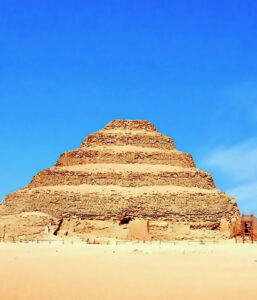The Pyramid of Zoser, also known as the Step Pyramid of Djoser, is one of the most important monuments in ancient Egyptian history. Located in the Saqqara necropolis, near Memphis, Egypt, this pyramid is renowned for being the first large-scale stone structure in history and is widely regarded as the earliest pyramid ever constructed. Commissioned by Pharaoh Djoser during the 27th century BC, this remarkable edifice stands as a testament to the ingenuity and architectural innovation of ancient Egypt.
The Pyramid of Zoser was constructed during the reign of Pharaoh Djoser, the second ruler of Egypt’s Third Dynasty. The mastermind behind this architectural marvel was Imhotep, the pharaoh’s chief architect, who is credited with revolutionizing ancient Egyptian architecture. Before this pyramid, Egyptian tombs were simple mastabas made of mudbrick. Imhotep’s vision led to the creation of the first monumental stone structure, setting a precedent for future pyramid construction.
The Step Pyramid is a uniquely designed structure, consisting of six mastabas (rectangular, flat-roofed tombs) stacked atop one another, each smaller than the one below it. This tiered design gives the pyramid its distinctive stepped appearance, rising to a height of approximately 62 meters (203 feet). Originally, the pyramid was clad in smooth, polished white limestone, which would have shone brightly in the Egyptian sun.
The pyramid complex is extensive, covering a large area with a variety of structures, including temples, courtyards, and shrines. The entire complex is surrounded by a massive enclosure wall, which served to protect the sacred area and symbolize the pharaoh’s divine status. The Pyramid of Zoser represents a significant evolution in the development of pyramid construction, leading to the smooth-sided pyramids seen at Giza.
The Pyramid of Zoser was built as a tomb for Pharaoh Djoser, intended to ensure his safe passage to the afterlife. In ancient Egyptian belief, the pyramid was not just a burial place but also a spiritual machine that facilitated the pharaoh’s ascent to the heavens, where he would join the gods and protect Egypt for eternity. The surrounding mortuary complex was designed for the performance of rituals and offerings that would sustain the pharaoh’s spirit in the afterlife.
This pyramid is also significant for being the first structure to use stone on such a massive scale. Imhotep’s innovative use of stone, along with his architectural vision, laid the groundwork for the development of more sophisticated pyramids, culminating in the construction of the Great Pyramids of Giza. Imhotep’s contributions to architecture were so profound that he was later deified and worshipped as a god of wisdom and medicine.
The Pyramid of Zoser has stood the test of time, surviving for over 4,600 years as a symbol of ancient Egypt’s grandeur. Although the structure has suffered from the effects of time and natural disasters, it remains one of the most well-preserved pyramids in Egypt. Extensive restoration efforts have been undertaken to stabilize and preserve the pyramid, ensuring that future generations can continue to marvel at this ancient wonder.
Today, the Pyramid of Zoser is a major tourist attraction and an essential site for those interested in ancient Egyptian history. It offers visitors a glimpse into the early development of pyramid construction and the spiritual beliefs that shaped the culture of ancient Egypt. The pyramid’s legacy as the first of its kind continues to inspire awe and admiration among historians, archaeologists, and travelers alike.
